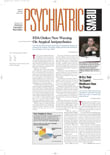Light therapy appears to be efficacious for seasonal affective disorder (SAD) and for nonseasonal depression, according to a meta-analysis of randomized controlled trials.
The analysis was reported in the April American Journal of Psychiatry. The lead author was Robert N. Golden, M.D., who led a work group charged by APA's Council on Research and Committee on Research on Psychiatric Treatments to use the principles of evidence-based medicine to examine the efficacy of light therapy.
Golden and colleagues found that many of the studies in the literature on light therapy did not meet selection criteria for the meta-analysis, reflecting methodological problems inherent in the study of light. Prominent among these is the difficulty of defining parameters of active versus placebo conditions.
“There is an unavoidable challenge in setting up a placebo condition that subjects cannot distinguish from active treatment, although this usually applies to pharmacotherapy research as well, whenever active treatments have side effects and placebos do not,” Golden told Psychiatric News.
Small sample size also characterized some studies that did not meet criteria, reflecting the lack of industry support for research on light, Golden said.
But those studies that did meet selection criteria for the meta-analysis demonstrated a significant reduction in depression symptom severity following bright light therapy in SAD and in nonseasonal depression. The analysis also showed a significant effect with “dawn simulation” in SAD. (Dawn simulation uses a light that comes on very slowly in the early morning, to imitate a natural sunrise. Standard light therapy typically makes use of a light box that provides persistent bright light.)
“When the `noise' from unreliable studies is removed, the effects of light therapy are comparable to those found in many antidepressant pharmacotherapy trials,” Golden and colleagues wrote.
They systematically searched PubMed for articles published between January 1975 and July 2003 on light therapy for mood disorders. Included studies were required to be randomized, controlled trials of patients in the acute phase of treatment and to have a credible placebo-control condition.
For bright light treatment of SAD, minimum treatment dose was defined as four days of at least 3,000 lux-hours (for instance, 1,500 lux for two hours or 3,000 lux for one hour). Placebo comparison groups were required to receive a maximum of 300 lux.
For dawn-simulation studies, active intervention was required to consist of increasing light exposure from 0 lux to 200-300 lux over one hour to 2.5 hours, and the placebo condition had to consist of an increase that was less than 5 lux and/or less than 15 minutes in duration.
Golden and colleagues found that only 23 of 173 studies (13 percent) met the selection criteria. But those 23 studies showed a significant reduction in depression symptom severity associated with bright-light treatment and dawn simulation in SAD.
Significant reduction in symptoms was also demonstrated with bright-light treatment in nonseasonal depression. Bright light as an adjunct to pharmacotherapy was not found effective, according to the report.
Norman Rosenthal, M.D., a psychiatrist who pioneered SAD research and treatment using light therapy, told Psychiatric News that the findings confirm that light is extremely effective in the treatment of patients with mood disorders and should help to push the treatment into the mainstream. He emphasized the finding that effect sizes for light therapy were comparable to those found for antidepressant medication.
He underscored the finding that light therapy was also found effective for nonseasonal depression. “I don't think if you asked 100 psychiatrists that even 5 percent would have endorsed that,” he said. “So it's a very interesting finding.”
He added that the finding should not be surprising given that light is known to impact fundamental neurotransmitter systems.
Rosenthal is a clinical professor of psychiatry at Georgetown University School of Medicine and author of Winter Blues. (The book was originally published in 1989 under the title Seasons of the Mind; it was republished under the new title in 1993, and a second edition was published by the Guilford Press in 1998. The third edition is due out this fall.)
Rosenthal believes the finding that light was not effective as an adjunct to pharmacotherapy is an artifact of the small number of studies that have been conducted on the subject.
It would be “extraordinary” for an antidepressant that is effective “in its own right not to be effective as an adjunct to something else,” he said. “That would be almost unprecedented, and my guess is that this is because the quantity of data is insufficient.”
Rosenthal said that research on light therapy today has come to a virtual standstill because of a lack of funding, and thus the therapy has been marginalized. Federal funding that had once been generous has dried up, and since equipment used for light therapy does not hold the promise of yielding huge profits for manufacturers, other sources of funding have not materialized.
“There is no money in light, and nobody has a lot to gain from it economically,” he said.
Am J Psychiatry 2005 162 656
